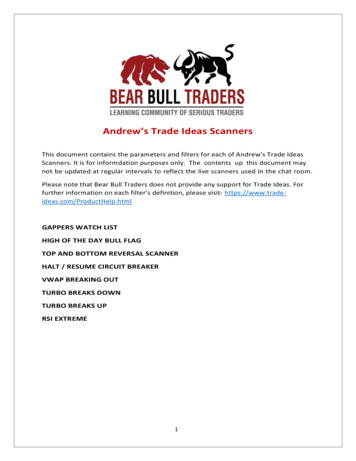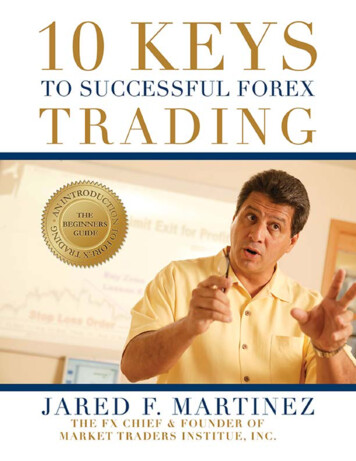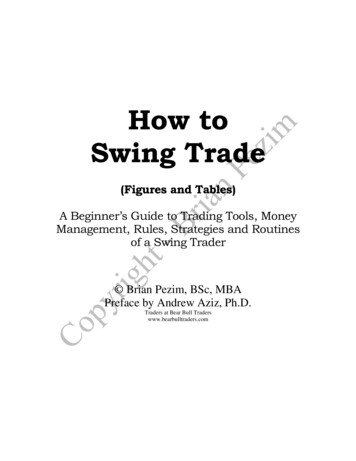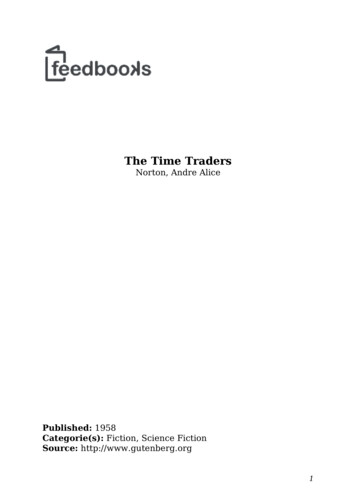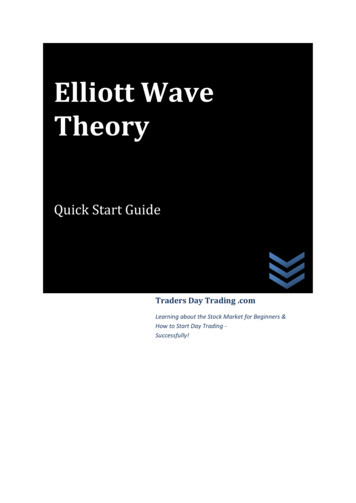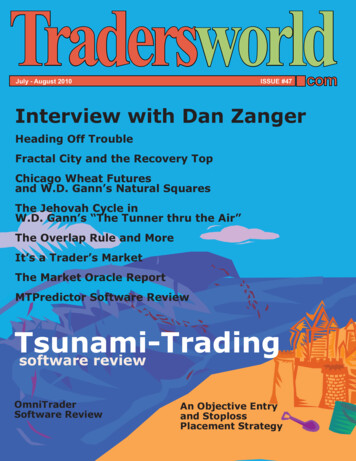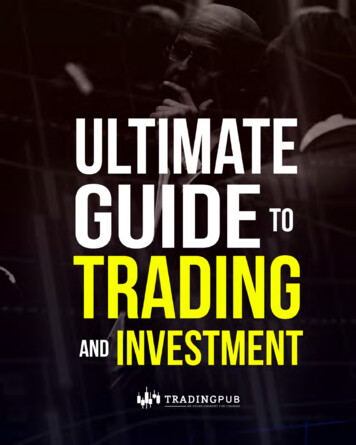
Transcription
Essential checklistsfor traders
Risk DisclaimerThere is a very high degree of risk involved in trading. Past results are not indicative of futurereturns. Tradingpub.com and all individuals affiliated with this site assume no responsibilitiesfor your trading and investment results. The indicators, strategies, columns, articles and allother features are for educational purposes only and should not be construed as investmentadvice. Information for futures trading observations are obtained from sources believed tobe reliable, but we do not warrant its completeness or accuracy, or warrant any results fromthe use of the information. Your use of the trading observations is entirely at your own riskand it is your sole responsibility to evaluate the accuracy, completeness and usefulnessof the information. By registering for this event your information may be shared with oureducational partners. You must assess the risk of any trade with your broker and makeyour own independent decisions regarding any securities mentioned herein. Affiliates oftradingpub.com may have a position or effect transactions in the securities described herein(or options thereon) and/or otherwise employ trading strategies that may be consistent orinconsistent with the provided strategies.Privacy Policy
How to Get the Most Out of This BookThank you for downloading “Ultimate Guide to Trading and Investment”. This book is designedfor beginning, intermediate and advanced traders. The authors in this book are leading expertsin trading Stocks, Options, Futures, Forex and Nadex.As you read this book, you will be exposed to multiple strategies that have high probabilities ofsuccess and/or high profit. Most of the chapters in this interactive eBook are divided into threesections: The Game Plan – An introduction to a charting technique. The strategy is thenthoroughly explained along with illustrations and examples. The Movie - A video that completely describes the strategy discussed in the chapter. Special Offers – If you really like a strategy, you can follow the presenter and thestrategy. There are thousands of dollars’ worth of trading tools, indicators, training andmentoring services, books and videos available at steeply discounted prices.In short, you should have all of the information you need to test and try out many of the newideas and concepts you will learn by reading this book.Some of the things you will learn in this book are: The patterns and habits that are common to all successful traders How to effectively use Market Profile for trading Futures A simple 1-2-3 strategy for trading Forex currency pairs An all-hours Options strategy for Naked Put writing A rule-based method for trading with the trend How to spot when Big Money is entering the market and how to trade on their side And so much more over 20 contributors with high probability strategies for tradingStocks, Options, Futures, Forex and Nadex.Limited Edition hardcopy of the Ultimate Guide to Trading & InvestmentFor the first time ever, the TradingPub has decided to produce a hardcopy edition of one of itspublications. You can now own a beautifully bound edition of the Ultimate Guide to Tradingand Investment - one of the greatest collections of trading and investment tips, tricks, tactics,and strategies every collected in one place. And best yet, 100% of profits will be donated tocharities to benefit low income children, raise awareness for cancer research, and give back tothe community. Tap this link to learn more about this limited time offer!Make sure you also subscribe to TradingPub. We provide free eBooks, webinars, on-demandvideos and many other publications for active traders in all of the markets. Our presenters areworld-renowned industry experts and our content is provided free of charge in a relaxed andfriendly setting. Cheers to your trading success!
Table of ContentsMarket Perspectives07 Successful Traders Handbookby Rick Saddler, Hit & Run Candlesticks17 30 Trading Insights to Help You Overcome Your Trading Fearsby Tom Busby, Diversified Trading InstituteSTOCKS28 High Profit Candlestick Signals and Patternsby Steve Bigalow, Candlestick Forum39 A Simple Method for Trading with the Trendby Jeffrey Gibby, MetaStock47 How To “Buy Low” for Bigger Profits, Less Stress,and More Enjoyable Tradingby Geoff Bysshe, Market Gauge60 Mastering the Perfect Pullback: Five Steps to Improve Your Trend Tradingby Corey Rosenbloom, Afraid To TradeFOREX72 A Simple 123 Forex Strategyby Jody Samuels, FX Traders Edge81 The London Breakout Sessionby Josh Martinez, Market Traders Institute86 What Is the Best Time to Trade Currencies?by Ricardo Menjivar, Phoenix Trading Strategies
OPTIONS97 How to Add Weekly Options to Your Trading Arsenalby Andrew Keene, Alpha Shark Trading105 Naked Put-Writing: A Strategy for All-Hoursby Lawrence McMillan, McMillan Asset Management116 Trading Earnings Straddlesby Kim Klaiman, Steady OptionsNADEX 127 Getting Started with Nadex Binary Optionsby Cam White, TradingPub137 Using Nadex Spreads as the Ultimate Hedge Strategyby Darrell Martin, Apex Investing Institute147 Creating Nadex Trading Plansby Sean Jantz, Binary Trade Group153 How to Find High Probability Trades Using Nadex Binary Optionsby Mark Hodge, Rockwell TradingFUTURES163 How to Use Market Profile to Trade Futuressby Greg Weitzman, The Trading Zone171 6 Essential Ingredients for Winning at Stock Index Trading”by Mohan Wolfe, Day Traders Action177 Trading On The Side Of Strengthby Peter Davies, Jigsaw Trading186 If I Had to Choose Only One Trading Indicatorby Mark Helwig, ValueCharts200 Trading the Trendsby David Katz, Trading Fibz
ultimate guide to trading and investmentMarket Perspectives6
ultimate guide to trading and investmentSuccessful Traders HandbookBy Rick Saddler, Hit and Run CandlesticksHABITS OF A SUCCESSFUL TRADEREvery trader has bad habits that they would like to change. Some habits are buried deep within andneed to be brought to the surface so they can be identified and changed.A good way to identify and change habits that are affecting your trading is to look at the habits ofsuccessful traders. While reading this chapter, do a self analysis of your habits by comparing themagainst the habits of successful traders. As you identify habits that you would like to change, writethem down and describe what action you will take to change these habits. Then take the actions thatyou describe.Have a plan for every trade. This means that you write down your entry, exit and stop loss strategyfor every trade. Then execute the trade and stick with the plan. If your trade is based on a dailychart, then follow the daily chart when monitoring your position. On your trade plan write the chartfrequency you will use to monitor the position. Some traders may decide to plan and monitor tradeson a daily basis but use a lower time frame chart such as a 60 minute chart to monitor a position thatis getting close to an exit area.Watching intraday charts for trades planned on daily charts can cause you to react emotionally andis one reason traders may close positions too early and not according to plan.This can have a detrimental effect on profits. Base your trade plan on what you see and not whatyou predict. What you see on a chart is fact. What you predict is fiction. No one has a crystal ball thataccurately predictsprice action but we all have charts that give us information that contain the factsabout price. One way to test yourself using predictions is to pay attention to your choice of words.Words like “I think”, “I feel” are most likely predictions.Know who you are as a trader and be your own trader. Do you have the personality for swing, day orlong term trading? Stick with the type of trading that fits with your lifestyle and personality.Be your own trader and don’t be a follower.You need to be confident in the trades you execute and this means understanding the trade andbelieving in the trade. Just because someone else takes a trade doesn’t mean it is right for you.7
ultimate guide to trading and investmentFocus on the best trades for you. Study stock charts and identify high probability setups. Start withone or two trade setups, master them and then add more setups.Have a “Trading Business Plan”. Every successful business owner has a business plan. Sincetrading is a business, traders should have a business plan. There is a lot of information out there ondesigning business plans. A suggestion is to keep it short and simple. A one or two page businessplan is sufficient for most traders. You can always add to it as you go along. The point is to have abusiness plan that is convenient and you will use as a reference to certain aspects of your trading.Important topics to address in thebusiness plan are Describe what kind of trader you are. Are you a day, swing or long term trader. What time frames during market hours will you be trading? How much capital do you have for trading and how much of that capital will youcommit to any one trade? What trade method and trade setups will you be trading? If you are trading pricepatterns, indicate what chart time frame and what patterns you will be trading. For each trade setup, describe the entry, exit and stop loss strategy. Include adescription of when you will add to a position, raise your stop and scale out of aposition. Under what conditions will you stop trading for the day, week or month. For example,“You (the trader) will stop trading for the day or week if you have 3 losing trades.” What is your trading goal? Describe any psychological rituals you will use to stay focused or get focused. Sometraders will use tapping sequences, meditation or other form of behavior modificationtechnique.8
ultimate guide to trading and investmentDocument every trade. Use a spreadsheet/log to document your trades. In addition, you may wantto mark up a stock chart for each trade. On the stock chart, you indicate your entry, target and stop.You can also mark resistance and support areas along with trendlines and other notations to helpmanage the trade. Many stock trading programs have an annotation feature that helps you mark upcharts. Save these marked up charts in a file or print them off for review.Review your trade journal/log and identify areas of improvement. This is one of the best ways to growas a trader. You may want to write a weekly summary of what you will do in the next week to improveyour trading.Know when to trade and have the discipline not to trade. Trade only when the market gives you cleardirection. If you are confused, have trouble finding trades that meet your rules or do not know what todo, these are signs that the market may be in a state of flux and not conducive to your style of trading.There are times to stay in cash or just manage the positions you have working. It is okay not to tradeevery day. In fact, forcing trades in an undesirable market often leads to losses. Have patience andwait for your setup!Accept your losses. No one is right all of the time and trade setups do not always go the way youwant them to. That is why you place stops with every trade entry. A stop is what you plan in advanceand are willing to risk for the reward you specified in the trade plan.Traders that don’t want to accept losses or set stops frequently let their losing trades run. They mayeven average down as price is falling only to watch the loss grow. Eventually, these traders are sodevastated financially and emotionally that many quit trading. Copy the sentence below and post itwhere you will see it.It is not whether you are right or wrong on a trade it is how much profit you accumulate in youraccount!Take action! You may have the best intentions by developing a plan for every trade and documentingevery trade. The most important thing is to execute the trade according to plan and to review yourdocumentation with a critical eye and make changes in your trading behavior that will improve yourtrading results. Be honest with yourself when evaluating your performance and take responsibility bytaking action to improve that performance.Have a trading goal. Set a realistic goal so that you have a benchmark for measuring your improvementand trading success. Some traders establish a daily, weekly or monthly monetary goal. You may alsoconsider a daily, weekly, or monthly percentage goal such as 2% return on capital per week. Set thegoal that makes the most sense for you. The point is “set a goal” and keep track of your progress inmeeting this goal.9
ultimate guide to trading and investmentDevelop the right attitude about your trading business. What does this mean? Take a proactiveapproach to achieve positive results. Actions you can take toward developing the right attitude are: Identify what you may need help with and “get help”. This can be finding a trading coach,signing up for a webinar, reading written material. Persevere! Don’t give up because you make mistakes. Learn from your mistakes by identifyingthem, writing what you will do to correct them and then act on what you write. Follow and execute all plans that you make. You constructed these plans for a reason sokeep these plans handy so you can refer to them often and take the planned action.By taking these actions you are being proactive to making the necessary improvements to keep yourtrading business moving in a positive direction. There will always be rough times. Successful tradersuse these times as an opportunity to learn and to grow their business.Thomas Edison once said: "Many of life's failures are people who did not realize how close theywereto success when they gave up."SUMMARY Habits of a successful trader are Have a plan for every trade Base your trade plan on what you see and not what you predict Know who you are as a trader and be your own trader Focus on the best trades for you Have a Trading Business Plan Document every trade Review your trade journal/log and identify areas of improvement Kno
The strategy is then thoroughly explained along with illustrations and examples. The Movie - A video that completely describes the strategy discussed in the chapter. Special Offers – If you really like a strategy, you can follow the presenter and the strategy. There are thousands of dollars’ worth of trading tools, indicators, training and mentoring services, books and videos .



